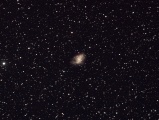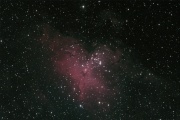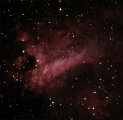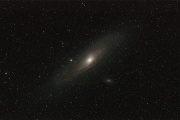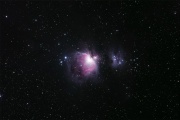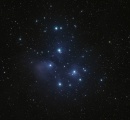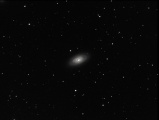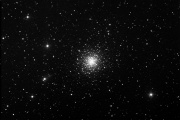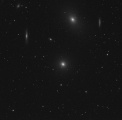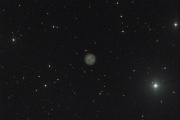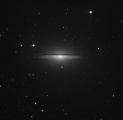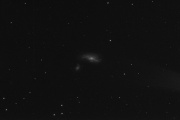Difference between revisions of "Astrophotography"
| (34 intermediate revisions by the same user not shown) | |||
| Line 1: | Line 1: | ||
| − | + | [[file:astrophotographyportfolio.jpg|thumb|300px|right|[http://www.tedvlango.com/astrophotography Astronomical Portfolio]]] | |
| + | Wikipedia describes '''Astrophotography''' as "a specialized type of photography that entails recording images of astronomical objects and large areas of the night sky. The first photograph of an astronomical object (the [http://en.wikipedia.org/wiki/Moon Moon]) was taken in 1840, but it was not until the late 19th century that advances in technology allowed for detailed stellar photography. Besides being able to record the details of extended objects such as the Moon, [http://en.wikipedia.org/wiki/Sun Sun], and [http://en.wikipedia.org/wiki/Planet Planets], astrophotography has the ability to image objects invisible to the human eye such as dim [http://en.wikipedia.org/wiki/Star stars], [http://en.wikipedia.org/wiki/Nebula nebulae], and [http://en.wikipedia.org/wiki/Galaxy galaxies]]. This is done by long time exposure since both film and digital cameras can accumulate and sum light [http://en.wikipedia.org/wiki/Photon photons] over these long periods of time. In professional astronomical research, photography revolutionized the field, with long time exposures recording hundreds of thousands of new stars and nebulae that were invisible to the human eye, leading to specialized and ever larger [http://en.wikipedia.org/wiki/Optical_telescopes optical telescopes] that were essentially big "cameras" designed to collect light to be recorded on film. Direct astrophotography had an early role in sky surveys and star classification but over time it has given way to more sophisticated equipment and techniques designed for specific fields of scientific research, with film (and later [http://en.wikipedia.org/wiki/Charge-coupled_device#Use_in_astronomy|astronomical CCD cameras]) becoming just one of many forms of sensor." | ||
| − | + | I personally conduct most of my astrophotography by leveraging the telescopes available to me via [http://www.itelescope.net iTelescop.net]. I started taking my first pictures using my own telescope in my teens, but as my professional career had me move over different parts of the country, it became difficult to impractical to continue shooting direct. In addition, the proper mounts and camera equipment can be very costly, and the trade-off of leveraging an IP based array of [[Telescopes|telescopes]] allows me the capability of shooting far more objects throughout the year. | |
| − | + | Currently, I am building out my [http://www.tedvlango.com/astrophotography portfolio of images]. | |
| − | + | I am also shooting the entire [[Messier Catalog]] leveraging these [[Telescopes|telescopes]]. With still more than 1/2 the year left, I have captured about 70% of the Messier objects. | |
| + | |||
| + | =Gallery= | ||
| + | |||
| + | Here a few samples. Visit [http://www.tedvlango.com/astrophotography portfolio of images] for more! | ||
| + | |||
| + | |||
| + | <gallery caption="Caption for gallery" widths=200px perrow=4 showfilename=all> | ||
| + | File:Messier1.jpg|Crab Nebula: A Supernova remnant, 8.4 magnitude | ||
| + | File:Messier8.jpg|Lagoon Nebula: A Nebula with cluster, 6 magnitude | ||
| + | File:Messier16.jpg|Eagle Nebula: A Nebula, H II region with cluster, 6 magnitude | ||
| + | File:Messier17.jpg|Omega, Swan, Horseshoe, or Lobster Nebula: A Nebula, H II region with cluster, 6 magnitude | ||
| + | File:Messier31.jpg|Andromeda Galaxy: A Galaxy, spiral, 3.4 magnitude | ||
| + | File:Messier42.jpg|Orion Nebula: A Nebula, H II region, 4 magnitude | ||
| + | File:Messier45.jpg|Pleiades: A Cluster, open, 1.6 magnitude | ||
| + | File:Messier64.jpg|Black Eye Galaxy: A Galaxy, spiral, 9.4 magnitude | ||
| + | File:Messier68.jpg|Messier 68: A Cluster, globular, 9.7 magnitude | ||
| + | File:Messier82.jpg|Cigar Galaxy: A Galaxy, starburst, 8.4 magnitude | ||
| + | File:Messier84.jpg|Messier 84: A Galaxy, lenticular, 10.1 magnitude | ||
| + | File:Messier97.jpg|Owl Nebula: A Nebula, planetary, 9.9 magnitude | ||
| + | File:Messier101.jpg|Pinwheel Galaxy: A Galaxy, spiral, 7.9 magnitude | ||
| + | File:Messier104.jpg|Sombrero Galaxy: A Galaxy, spiral, 9 magnitude | ||
| + | File:Messier109.jpg|Messier 109: A Galaxy, barred spiral, 10.6 magnitude | ||
| + | File:NGC4490.jpg|NGC 4490: "The Cocoon Galaxy", spiral spiral, 10.6 magnitude | ||
| + | </gallery> | ||
Latest revision as of 14:13, 18 May 2014
Wikipedia describes Astrophotography as "a specialized type of photography that entails recording images of astronomical objects and large areas of the night sky. The first photograph of an astronomical object (the Moon) was taken in 1840, but it was not until the late 19th century that advances in technology allowed for detailed stellar photography. Besides being able to record the details of extended objects such as the Moon, Sun, and Planets, astrophotography has the ability to image objects invisible to the human eye such as dim stars, nebulae, and galaxies]. This is done by long time exposure since both film and digital cameras can accumulate and sum light photons over these long periods of time. In professional astronomical research, photography revolutionized the field, with long time exposures recording hundreds of thousands of new stars and nebulae that were invisible to the human eye, leading to specialized and ever larger optical telescopes that were essentially big "cameras" designed to collect light to be recorded on film. Direct astrophotography had an early role in sky surveys and star classification but over time it has given way to more sophisticated equipment and techniques designed for specific fields of scientific research, with film (and later CCD cameras) becoming just one of many forms of sensor."
I personally conduct most of my astrophotography by leveraging the telescopes available to me via iTelescop.net. I started taking my first pictures using my own telescope in my teens, but as my professional career had me move over different parts of the country, it became difficult to impractical to continue shooting direct. In addition, the proper mounts and camera equipment can be very costly, and the trade-off of leveraging an IP based array of telescopes allows me the capability of shooting far more objects throughout the year.
Currently, I am building out my portfolio of images.
I am also shooting the entire Messier Catalog leveraging these telescopes. With still more than 1/2 the year left, I have captured about 70% of the Messier objects.
Gallery
Here a few samples. Visit portfolio of images for more!
- Caption for gallery
Messier1.jpg
Crab Nebula: A Supernova remnant, 8.4 magnitudeMessier8.jpg
Lagoon Nebula: A Nebula with cluster, 6 magnitudeMessier16.jpg
Eagle Nebula: A Nebula, H II region with cluster, 6 magnitudeMessier17.jpg
Omega, Swan, Horseshoe, or Lobster Nebula: A Nebula, H II region with cluster, 6 magnitudeMessier31.jpg
Andromeda Galaxy: A Galaxy, spiral, 3.4 magnitudeMessier42.jpg
Orion Nebula: A Nebula, H II region, 4 magnitudeMessier45.jpg
Pleiades: A Cluster, open, 1.6 magnitudeMessier64.jpg
Black Eye Galaxy: A Galaxy, spiral, 9.4 magnitudeMessier68.jpg
Messier 68: A Cluster, globular, 9.7 magnitudeMessier82.jpg
Cigar Galaxy: A Galaxy, starburst, 8.4 magnitudeMessier84.jpg
Messier 84: A Galaxy, lenticular, 10.1 magnitudeMessier97.jpg
Owl Nebula: A Nebula, planetary, 9.9 magnitudeMessier101.jpg
Pinwheel Galaxy: A Galaxy, spiral, 7.9 magnitudeMessier104.jpg
Sombrero Galaxy: A Galaxy, spiral, 9 magnitudeMessier109.jpg
Messier 109: A Galaxy, barred spiral, 10.6 magnitudeNGC4490.jpg
NGC 4490: "The Cocoon Galaxy", spiral spiral, 10.6 magnitude

